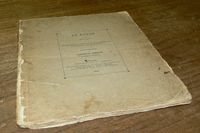SIAM News Story Helps Uncover a Copy of Green�s Essay of 1828
November 19, 2007

Robert E. O'Malley, Jr.
We don't know much about George Green (1793�1841). What we do know is found in Mary Cannell's eloquent biography, published by SIAM shortly after her death in 2000. It was my pleasure to know this elegant Englishwoman, who devoted her retirement years to learning about Green and his impact.
Green was a miller in Sneinton, near Nottingham, who taught himself continental mathematics, presumably by reading works of Poisson, Laplace, and others from Bromley House, the Nottingham Subscription Library, which he joined in 1823. His famous work of 1828, "An Essay on the Application of Mathematical Analysis to the Theories of Electricity and Magnetism," was printed by T. Wheelhouse of Nottingham for the author. According to Cajori [3], about 100 copies were printed. Fifty-one were sold at a price of 7 s., 6 d. (the weekly wage of a Nottingham stocking maker) to a list of subscribers obtained through advertisements in the Nottingham Review and Nottingham Journal in December 1827. In her biography of Green, Cannell [4] reports that local "clergymen, doctors, and the prosperous lace and textile manufacturers and merchants . . . made up more than half the subscribers." The book was also available from a few booksellers in Nottingham, Cambridge, and London.
The Essay is best known as the source of Green's theorem (cf. Cross [6] and Archibald [1]), the electric potential, and the kernel now called a Green's function (cf. Schwinger [8] and Challis and Sheard [5]). Green's preface ends with the paragraph:
"Should the present Essay tend in any way to facilitate the application of analysis to one of the more interesting of the physical sciences, the author will deem himself amply repaid for any labour he may have bestowed upon it; and it is hoped the difficulty of the subject will incline mathematicians to read the work with indulgence, more particularly when they are informed that it was written by a young man, who has been obliged to obtain the little knowledge he possesses, at such intervals and by such means, as other indispensible avocations which offer few opportunities of mental improvement, afforded."
The work was largely forgotten until William Thomson, later Lord Kelvin, rediscovered it in 1845. Recently, Chelsea (New York), The George Green Memorial Fund (Nottingham), and Stig Ekelof (Goteborg) have published reprint editions. (Green's restored windmill, where George and his mistress Jane Smith lived with their seven offspring, is now a science center, popular with children visiting Nottingham.)
To help publicize Cannell's book, I wrote about Green in SIAM News in 2000 [7]. In November 2003, Eric Bal, a lawyer in North Bergen, New Jersey, came across that article on the Web. On reading my description of a 1998 sale of rare books by the University of Keele that included a copy of Green's Essay (and that the British Society for the History of Mathematics labeled "a most horrible infamy"), Eric realized that he had had a copy of the Essay in his attic for the last twenty-five years! Its previous owner was a German engineer who migrated to America; upon his death, his landlord gave his collection of about 2000 books to the Austin Bookshop in Kew Gardens, Queens. The bookstore issued a catalog and had sold about half the books by 1978, when Eric wandered in. He was able to buy the remainder for $1000. Eric contacted me after reading the SIAM News article [2]; I visited him in August 2004, and after touring his home/office library of 12,000 books, all nonfiction and mostly about math, physics, and computing, offered to buy the Essay.
Eric has now sold me his copy of the Essay, which includes penciled comments in German. I'm grateful that he did, although I undoubtedly overpaid--the market is limited (as SIAM has found for Cannell's excellent biography). The last known previous sale, at a Sotheby auction in November 1979, was for �800. The most important copies of the Essay are certainly those given Thomson upon his graduation from Cambridge as Senior Wrangler by his Mathematical Tripos coach William Hopkins. Six later papers by Green, inscribed to "Professor Jacobi, from the author," were auctioned at Sotheby's in 1976.
By studying the Austin catalog, could we figure out who the German engineer was? And what about earlier owners? Meanwhile, even if these and other questions are never answered, Cannell has taught us how interesting a mathematician that English miller really was.
References
[1] T. Archibald, Connectivity and smoke-rings: Green's identity in its first fifty years, Mathematics Magazine, 62 (1989), 219�232.
[2] E.J. Bal, personal correspondence, 2007.
[3] F. Cajori, A History of Mathematics, Macmillan, London, 1919.
[4] D.M. Cannell, George Green, Mathematician and Physicist, 1793�1841: The Background to his Life and Work, SIAM, Philadelphia, 2001.
[5] L. Challis and F. Sheard, The Green of Green's functions, Physics Today, December (2003), 41�46.
[6] J.J. Cross, Integral theorems in Cambridge mathematical physics, 1830�1855, in Wranglers and Physicists: Studies in Cambridge Physics in the Nineteenth Century, P.M. Harman, ed., Manchester University Press, Manchester, UK, 1985, 112�148.
[7] R.E. O'Malley, Jr., Scientific justice for George Green, SIAM News, September 2000, http://www.siam.org/news/news.php?id=666.
[8] J. Schwinger, The Greening of quantum field theory: George and I, in George Green, Mathematician and Physicist, 1793�1841: The Background to his Life and Work, SIAM, Philadelphia, 2001, 220�231.
Former SIAM president (1991�92) Robert E. O'Malley, Jr., is a professor in the Department of Applied Mathematics at the University of Washington.

